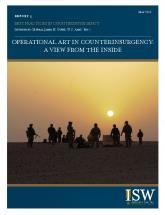 |
 |
Operational Art in Counterinsurgency: A View From The Inside

Executive Summary
by LTG James M. Dubik, U.S. Army (Ret.)
- This monograph provides a framework for understanding operational art in counterinsurgency campaigns, particularly those the U.S. and its allies conducted in Iraq and Afghanistan. It uses the counterinsurgency campaign in Iraq during 2007 and 2008 as a case study. It draws upon the author’s experience in Iraq during this time, as well as interviews with a number of other civil and military leaders who served in Iraq during the surge period.
- The term “operational art” describes the practice of using tactical military forces in sequence or simultaneously; in battles, engagements, and maneuvers; and in a campaign or series of campaigns to achieve strategic aims. In conventional war, the product of successful operational art is linear: a front line that progress as enemy units are destroyed or captured, territory held by the enemy is liberated, and enemy capitals are seized.
- What one sees as the result of operational art in a counterinsurgency campaign, at least for insurgencies like those in Iraq and Afghanistan, is significantly different than from a conventional campaign.
- Operational art in counterinsurgency appears more impressionistic and mosaic: a complex series of tactical, operational, and strategic transitions. These transitions require the employment of military, political, economic, and diplomatic “forces” in sequence and simultaneously.
- The set of tactical transitions are straightforward: friendly military and paramilitary police forces first clear out the insurgents and hand off security responsibilities to a combination of intervening and indigenous military or police forces that then hold what was gained from the insurgents. Then, the legitimate government, aided by the intervening powers, can build by conducting reconstruction, governmental, and economic development activities in order to establish a growing sense of normalcy.
- Each of these tactical transitions can take weeks and months. There is no well-defined time for the transition from clearing to holding or holding to building. Success in one transition sets the conditions for potential success in the next, but each has its own requirements and difficulties. Success in one phase does not guarantee success in the next. Timetables are helpful, but it is important not to declare prematurely that the transitions are complete.
- Operational level transitions involve shifting large parts of the host nation from the control of the intervening forces to the host nation government and its security forces. Normally, four elements are essential for successful operational level transitions: security, governance, adjudication, and reconstruction. Planning for these elements should begin as early as possible in the intervention, if not before. Work during the hold and build phases sets the conditions for operational level transitions. Conditions on the ground are the best gauge when it comes to executing operational level transitions. Regardless, metrics used to guide movement toward transfer are more subjective than empirical.
- At some point during the set of operational transitions, leaders may be tempted to claim that the conflict is over. But successful tactical and operational transitions must be followed by a period of strategic transition, which has its own set of actions to be accomplished.
- Strategic transitions, as far as a counterinsurgency campaign is concerned, generally fall into five categories: institutional, governmental, security sector, economic, and organizational. The strategic transition period is not equivalent to normal peacetime diplomatic activities. The period of strategic level transition is aimed at the space between war and peace. The period of strategic transition helps continue moving the political discourse from the language of violence to the language of politics.
- In conceiving and executing a counterinsurgency campaign, the cultural, historical, and societal details of the host nation are vitally important, as is understanding the unique circumstances of a nation’s insurgency. Yet patterns emerge from a study of insurgencies and counterinsurgencies, and patterns suggest principles. One of the principles that remain constant: success requires civil-military unity of purpose and coherency of action throughout a counterinsurgency campaign.
- Enough civil and military leaders in the intervening nation and the host nation must work together to achieve sufficient overall coherency in the actions each is responsible to execute. Furthermore, this coherency must last over time, take into account actions the host government and its security forces will initiate, and be flexible enough to adapt to changes in the enemy’s behavior and other aspects of the environment.
- The probability of success in waging a counterinsurgency campaign increases, however, when proper civil-military leadership teams—using adequate planning documents, processes, and organizations—are in place. The surge period in Iraq during 2007 and 2008 provides an example of the power of sufficient alignment that resulted in coherence among the civil-military organizations executing a counterinsurgency campaign.
- Four factors were essential for success in Iraq: strong and capable civilian and military leaders who can achieve alignment throughout the breadth and depth of their organizations; the use of a centrally guiding document; a campaign plan; a properly constructed organization; and a set of managerial practices that help the overall organization stay centered on leaders’ goals.
- It is necessary to take seriously the adjustments that both the State Department and Defense Department must make to jointly and systematically train and educate leaders, to expand the understanding of operational art as a civil-military activity, and to institute a proper set of civil-military exercises.